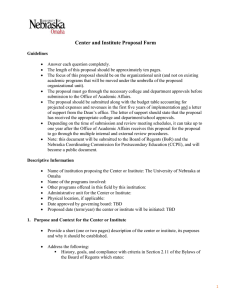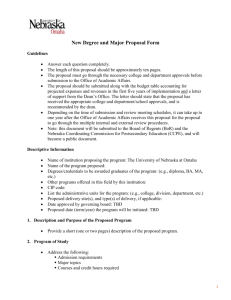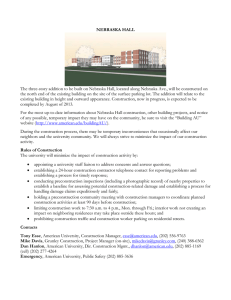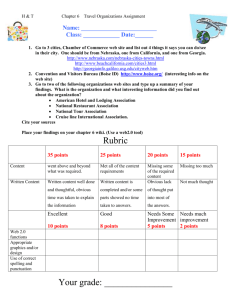College, School and Department Proposal Form
advertisement
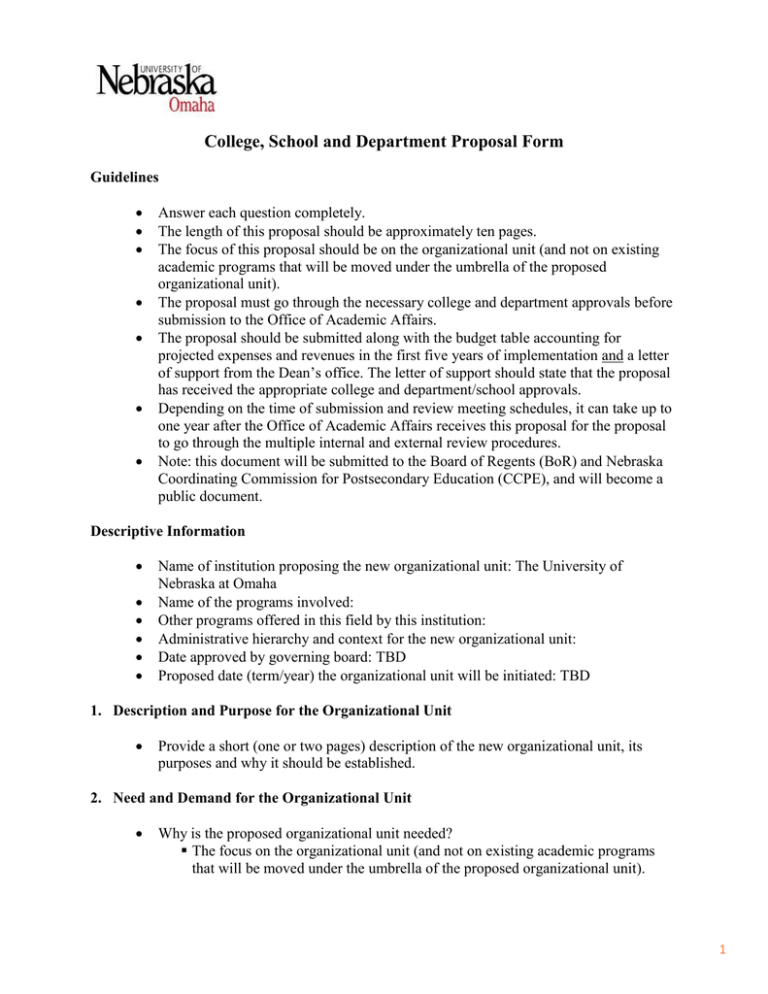
College, School and Department Proposal Form Guidelines Answer each question completely. The length of this proposal should be approximately ten pages. The focus of this proposal should be on the organizational unit (and not on existing academic programs that will be moved under the umbrella of the proposed organizational unit). The proposal must go through the necessary college and department approvals before submission to the Office of Academic Affairs. The proposal should be submitted along with the budget table accounting for projected expenses and revenues in the first five years of implementation and a letter of support from the Dean’s office. The letter of support should state that the proposal has received the appropriate college and department/school approvals. Depending on the time of submission and review meeting schedules, it can take up to one year after the Office of Academic Affairs receives this proposal for the proposal to go through the multiple internal and external review procedures. Note: this document will be submitted to the Board of Regents (BoR) and Nebraska Coordinating Commission for Postsecondary Education (CCPE), and will become a public document. Descriptive Information Name of institution proposing the new organizational unit: The University of Nebraska at Omaha Name of the programs involved: Other programs offered in this field by this institution: Administrative hierarchy and context for the new organizational unit: Date approved by governing board: TBD Proposed date (term/year) the organizational unit will be initiated: TBD 1. Description and Purpose for the Organizational Unit Provide a short (one or two pages) description of the new organizational unit, its purposes and why it should be established. 2. Need and Demand for the Organizational Unit Why is the proposed organizational unit needed? The focus on the organizational unit (and not on existing academic programs that will be moved under the umbrella of the proposed organizational unit). 1 Justification to create a School: The University of Nebraska adopted comprehensive criteria that guide the establishment of new schools within its campuses. This policy dictates that schools should possess most of the following characteristics: (1) be composed of several disciplinary areas with the complexity of composition and programs that lies between that of a University of Nebraska department and college; (2) the academic makeup of the proposed school combines areas that have previously been, or could be, academic departments; (3) the school represents a proposed organizational structure that is commonly found at other universities across the United States; (4) the school has programs at the post-baccalaureate level and a number of degrees or concentrations at the undergraduate level; and (5) the faculty of the proposed school must have engaged in significant and diverse scholarly activities with national and regional impact. 3. Adequacy of Resources What resources are required to implement and maintain the proposed organizational unit for the first five years and long term? Specifically address: Number of faculty and staff required Physical facilities needed Instructional equipment and informational resources Differentiate between currently available resources, and additional resources needed. Provide any necessary explanations to complement the CCPE-approved budget table submitted. Please ensure consistency between the CCPE-approved budget tables, the footnotes in the budget tables, and the proposal narrative. 4. Organizational Structure and Administration Describe the administrative structure of the proposed organizational unit. Address the following: Leadership Faculty Staff Committees Participating departments/units 5. Partnerships with Businesses List relevant partnerships with businesses Discuss potential business collaborations anticipated 6. Collaborations with Higher Education Institutions and Agencies External to the University 2 List partnerships with other colleges, universities, and agencies, and describe the nature of the partnerships. 7. Constituencies to be Served Identify constituencies (internal and external entities and/or people) to be served by the new organizational unit. 8. Anticipated outcomes, Significance, and Specific Measures of Success Describe the intended impact of establishing the new organizational unit. Identify quantitative measures to assess success, including a timetable for initial and periodic evaluation. 9. Centrality to Role and Mission of the Institution To what extent does the proposed organizational unit support UNO’s Mission Statement and Strategic Plan? Click here for more information. 10. Consistency with the University of Nebraska Strategic Framework To what extent does the proposed organizational unit support the University of Nebraska Strategic Framework? Click here for more information. 11. Potential for the Organizational Unit to Contribute to Society and Economic Development 12. Consistency with the Comprehensive Statewide Plan for Postsecondary Education How does the proposed organizational unit support relevant statewide goals for education? Click here to read the Comprehensive Statewide Plan for Postsecondary Education. Note that chapters 3, 4, 8, 9, and 10 are responsive to CCPE guidelines consistent with statutory provisions in LB816 (1999) which states (excerpted): “The commission shall establish criteria for the review, monitoring, and approval or disapproval of programs. The governing boards of the public institutions shall be responsible for assuring the quality and effectiveness of programs offered by their institutions. The commission’s criteria shall be designed to (a) meet educational needs and (b) assure efficiency and avoid unnecessary duplication.” Criteria shall include: (i) (ii) (iii) (iv) Centrality to the role and mission of the public institution; Consistency with the comprehensive statewide plan; Evidence of need and demand; and Adequacy of resources to support proposed new programs. 3 The criteria shall not infringe on the prerogative of the governing boards to make decisions on the quality of staff and the design of curriculum. 4
